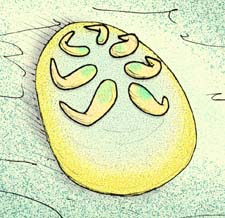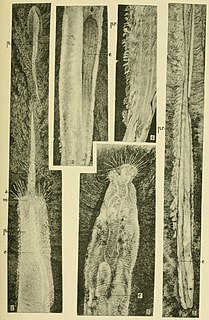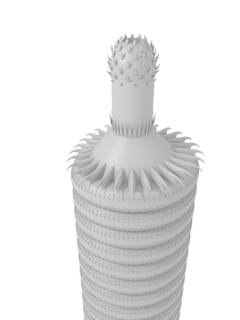
A sclerite is a hardened body part. In various branches of biology the term is applied to various structures, but not as a rule to vertebrate anatomical features such as bones and teeth. Instead it refers most commonly to the hardened parts of arthropod exoskeletons and the internal spicules of invertebrates such as certain sponges and soft corals. In paleontology, a scleritome is the complete set of sclerites of an organism, often all that is known from fossil invertebrates.

Microdictyon is an extinct "armored worm" coated with net-like scleritic scales, known from the Early Cambrian Maotianshan shale of Yunnan China and other parts of the world. Microdictyon is sometimes included in a somewhat ill-defined Phylum – Lobopodia – that includes several other odd worm-like and segmented free-swimming animals that do not appear to be arthropods or worms. The phylum includes Microdictyon, Onychodictyon, Cardiodictyon, Luolishania, and Paucipodia. The isolated sclerites of Microdictyon are known from other Lower Cambrian deposits. Microdictyon sclerites appear to have moulted; one sclerite seems to have been preserved during ecdysis.

Cro-Magnon is an Aurignacian site, located in a rock shelter at Les Eyzies, a hamlet in the commune of Les Eyzies-de-Tayac-Sireuil, Dordogne, southwestern France. Abri de Cro-Magnon is part of the UNESCO World Heritage of the Prehistoric Sites and Decorated Caves of the Vézère Valley.

In 2-dimensional geometry, a glide reflection is a symmetry operation that consists of a reflection over a line and then translation along that line, combined into a single operation. The intermediate step between reflection and translation can look different from the starting configuration, so objects with glide symmetry are in general, not symmetrical under reflection alone. In group theory, the glide plane is classified as a type of opposite isometry of the Euclidean plane

Biostratigraphy is the branch of stratigraphy which focuses on correlating and assigning relative ages of rock strata by using the fossil assemblages contained within them. The primary objective of biostratigraphy is correlation, demonstrating that a particular horizon in one geological section represents the same period of time as another horizon at a different section. Fossils within these strata are useful because sediments of the same age can look completely different, due to local variations in the sedimentary environment. For example, one section might have been made up of clays and marls, while another has more chalky limestones. However, if the fossil species recorded are similar, the two sediments are likely to have been laid down around the same time. Ideally these fossil are used to help identify biozones, as they make up the basic biostratigraphy units, and define geological time periods based upon the fossil species found within each section.
Markuelia is a genus of fossil worm-like bilaterian animals allied to Ecdysozoa and known from strata of Lower Cambrian to Lower Ordovician age containing five species.

Placodermi is a class of armoured prehistoric fish, known from fossils, which lived from the Silurian to the end of the Devonian period. Their head and thorax were covered by articulated armoured plates and the rest of the body was scaled or naked, depending on the species. Placoderms were among the first jawed fish; their jaws likely evolved from the first of their gill arches. Placoderms are thought to be paraphyletic, consisting of several distinct outgroups or sister taxa to all living jawed vertebrates, which originated among their ranks. This is illustrated by a 419-million-year-old fossil, Entelognathus, from China, which is the only known placoderm with a type of bony jaw like that found in modern bony fishes. This includes a dentary bone, which is found in humans and other tetrapods. The jaws in other placoderms were simplified and consisted of a single bone. Placoderms were also the first fish to develop pelvic fins, the precursor to hindlimbs in tetrapods, as well as true teeth. Paraphyletic groupings are problematic, as one can not talk precisely about their phylogenic relationships, characteristic traits, and complete extinction. 380-million-year-old fossils of three other genera, Incisoscutum, Materpiscis and Austroptyctodus, represent the oldest known examples of live birth. In contrast, one 2016 analysis concluded that placodermi are likely monophyletic.

Polacanthus, deriving its name from the Ancient Greek polys-/πολύς- "many" and akantha/ἄκανθα "thorn" or "prickle", is an early armoured, spiked, plant-eating ankylosaurian dinosaur from the early Cretaceous period of England.

The Emu Bay Shale is a geological formation in Emu Bay, South Australia, containing a major Konservat-Lagerstätte. It is one of two in the world containing Redlichiidan trilobites. The Emu Bay Shale is dated as Cambrian Series 2, Stage 4, correlated with the upper Botomian Stage of the Lower Cambrian.
The small shelly fauna, small shelly fossils (SSF), or early skeletal fossils (ESF) are mineralized fossils, many only a few millimetres long, with a nearly continuous record from the latest stages of the Ediacaran to the end of the Early Cambrian Period. They are very diverse, and there is no formal definition of "small shelly fauna" or "small shelly fossils". Almost all are from earlier rocks than more familiar fossils such as trilobites. Since most SSFs were preserved by being covered quickly with phosphate and this method of preservation is mainly limited to the Late Ediacaran and Early Cambrian periods, the animals that made them may actually have arisen earlier and persisted after this time span.

Tamga hamulifera is a disk-shaped fossil from Precambrian strata of the White Sea area, in Russia.

The palaeoscolecids are a group of extinct ecdysozoan worms resembling armoured priapulids. They are known from the Lower Cambrian to the late Silurian; they are mainly found as disarticulated sclerites, but are also preserved in many of the Cambrian lagerstätten. They take their name from the typifying genus Palaeoscolex.

Cricocosmia is a genus of palaeoscolecid worm from the Early Cambrian Chengjiang biota.

Louisella is a genus of worm known from the Middle Cambrian Burgess Shale. It was originally described by Charles Walcott in 1911 as a holothurian echinoderm, and represents a senior synonym of Miskoia, which was originally described as an annelid. 48 specimens of Louisella are known from the Greater Phyllopod bed, where they comprise < 0.1% of the community. It has been stated to have palaeoscolecid-like sclerites, though this is not in fact the case.
Quadratapora is a genus of lobopodian known only from its biomineralized dorsal plates, which somewhat resemble those of Microdictyon. Its fossils date to the Tommotian, representing the earliest record of lobopodians.
Onychomicrodictyon is a genus of Toyonian net-like small shelly fossil that probably belonged to a lobopodian resembling Onychodictyon or Microdictyon; the plates have a honeycomb structure with nodal flanges and an apical spinose extension.
Palaeoscolex is the type genus of the Palaeoscolecid worms, and served as a wastebasket taxon. until its taxonomy was revised and many of its taxa assigned to Wronascolex.

Scathascolex is a genus of palaeoscolecid worm known from the middle Cambrian Burgess Shale. It is the only taxon in that famous locality to exhibit the phosphatic plates that characterize palaeoscolecids, and has certain unusual characteristics – it does not have the multiple sizes of tessellating plates more typical of palaeoscolecids, and has more tail hooks than is the norm. Nevertheless, it is clearly a close relative of Palaeoscolex and Wronascolex.

Onychodictyon is an extinct armored worm known from the Lower Cambrian Chengjiang Maotianshan Shales in the Yunnan Province in China. Onychodictyon's segmented body and stubby non-segmented legs place it in the phylum Lobopodia, which includes several other segmented and free swimming animals such as Microdictyon, Cardiodictyon, Luolishania, and Paucipodia.












